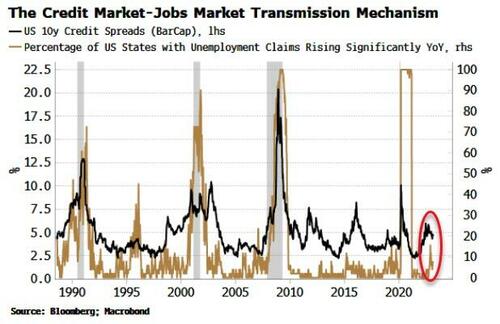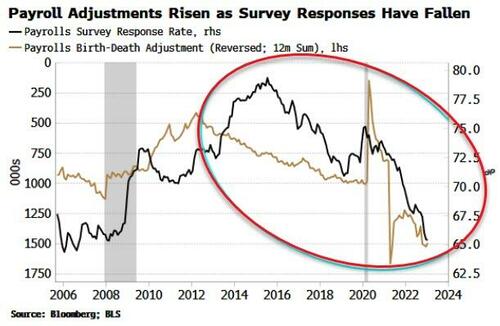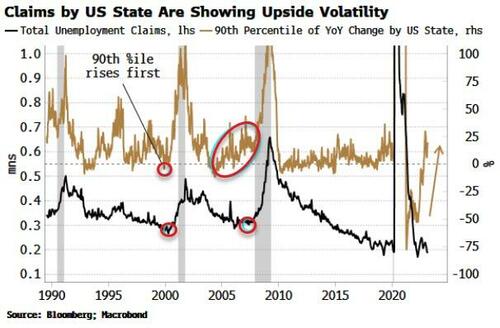Authored by Simon White, Bloomberg macro strategist,
Markets are poised this week for another pivotal US jobs report, but risk-assets are exposed to further downside from a labor market that may not be as robust as surface data imply.
“He who knows only his own case, knows little of that,” said John Stuart Mill. With the Fed and most other market participants using a dashboard showing a strong labor market, risk-reward favors examining the case that employment is not as strong as the data infer.
If the dashboard is indeed faulty, downside equity protection looks cheap, credit spreads look too tight, the VIX looks underpriced, and rates look too high, as the forgotten-about Fed pivot makes a return.
A worsening job market would quickly show up in credit spreads and spill over to equities. The chart below shows the linkage between markets and the real economy. They interact in multiple ways, but the most direct is between employment (e.g. unemployment claims), and credit spreads.
That’s because when an economy slows, the friction costs associated with hiring new workers dissuades firms from firing them too quickly. This stresses the cash flows used to pay back debt-holders, and credit spreads widen. If the firm can weather the storm, unemployment need not pick up. But if the slowdown becomes a recession, unemployment and spreads become locked in a self-reinforcing feedback loop.
So why should we question the jobs data?
To start with, historically low survey-participation rates are potentially leading to a rise in model-driven adjustments to the data.
Payrolls has seen its response rate fall sharply through the pandemic, in a trend beginning around 2015. The BLS uses a “birth-death” model to take account of expired firms that have gone out of business and new firms created, with the model adding 1.3 million jobs since last March.
The model first excludes firm deaths for the month, as these have historically netted off with new firms born. Non-respondents are counted as a death and are also excluded. Then, statistical methods are used to try to account for the remaining adjustment.
A falling response rate means more firm “deaths,” and therefore the model has to adjust more. The chart below shows that the birth-death model has added more jobs as the survey response rate has fallen.
The usual caveat of correlation/causation applies here. The model may be sound, but the greater the work it is having to do naturally raises the risk that reported numbers could be significantly different from what is really happening.
We may be beginning to see these adjustments come through. The payrolls data is based on a sample of about 400,000 establishments covering almost a third of US jobs, but that data is updated with the Quarterly Consensus on Employment and Wages (QCEW). That uses unemployment insurance data covering 95% of jobs, so is a very accurate read.
Unfortunately, we only get the data with a significant lag. But the QCEW for 2Q22 was recently released, revising payrolls lower by 287k in that quarter. This was driven by a jump in gross job losses. If the payrolls survey is over-compensating for job losses with the birth-death model, this may be starting to show out of last year’s data.
If this trend in rising gross job losses continues, we would soon find out the labor market is already much weaker than it appears, both last year and now.
This is not confined to payrolls.
The JOLTS survey, which has shown a large jump in job openings and an elevated quits rate also invites skepticism, given its response rates have collapsed by half since 2019 to about 30%.
The small sample size means the survey is being compiled using data from about 6,500 establishments, a tiny fraction of the 11 million total. The JOLTS survey uses a similar birth-death model to payrolls to make adjustments.
Again, this is not to say the data are cataclysmically wrong, but that caution should be applied in taking the data at face value, given the vulnerability of asset prices if it is not accurate.
This is doubly the case when several leading indicators are already pointing to a much weaker labor market in the coming months. Temporary employment typically leads payrolls by about six months, and is now contracting on an annual basis.
Unemployment claims has been the outlier to forthcoming signs of employment weakness, but that may soon change. The 90th percentile of the annual change in claims by US state captures regime shifts in the economy, and has recently risen sharply.
Such moves preceded higher nationwide claims prior to the last two recessions (ex-2020).


















